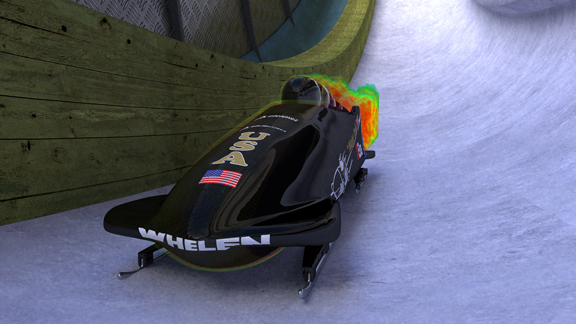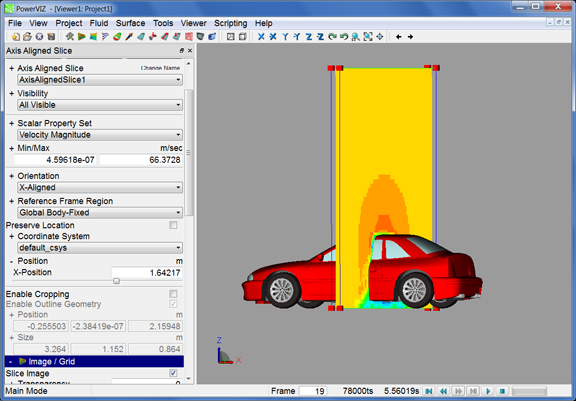Latest News
January 16, 2014
In Winter Olympics 2010, Steve Holcomb led a four-men Night Train 2 team that won a gold medal. In less than a month from now, Holcomb’s team will be riding again in the Winter Games in Sochi, Russia.
To keep the sports fair, the Federation keeps the competing vehicles within strict guidelines. They’re confined to maximum width and length. There are weight specifications for the sled including the crew and excluding the crew. So finding wiggle rooms to improve the vehicle’s aerodynamics is a difficult task.
In 2010, that task belonged to Bo-Dyn. To study the aerodynamics of the sled’s chassis, Bo-Dyn turned to Exa corporation, a simulation software developer. The collaboration stemmed from the two companies’ previous works in motorsports projects.
“From the time we got our marching orders to the time we needed to come up with some design alternatives, it was only a few weeks,” recalled Brad Duncan, director of aerodynamics applications at Exa. “[Bo-Dyn] really didn’t have enough time for wind tunnel testing. They needed something they could start producing.”
To perform a proper wind-tunnel test on the chassis, both the sled and the crew would have to be subjected to the wind pressure for long hours. “It would have been very arduous for the crew to sit still and do a full day of tests. The fatigue would set in eventually,” Duncan imagined. That anticipated discomfort nudged Bo-Dyn to rely instead on virtual airflow simulation.
“You’re trying to optimize the shape of something that’s basically a bullet—with people riding on it,” said Duncan. “We tried everything we could think of to improve it. We had no idea what the results would be, so we tried a few ideas. It was really a brainstorming exercise.” The front, the nose, the cowling, the fins—everything was fair game, as Duncan remembered.
Bo-Dyn and Exa first had the crew in position in the chassis mimicking a downhill ride, then obtained a point-cloud scan to capture the geometric volume they needed to study. In the mesh model, Exa employed fine meshes for areas that were deemed critical to the performance, and coarse meshes for the rest, according to Michelle Murray-Ross, Exa’s director of marketing. It took about half a dozen simulation just to understand the aerodynamics of the vehicle, Duncan recalled.
Later, Exa, Bo-Dyn, and the Bobsled team studied and discussed one-off design alternatives to arrive at an optimal shape. “In the end, we ended up running roughly two dozens simulations,” said Duncan. “We didn’t take the brute-force approach [running hundreds of simulations to find the best one]. We used an iterative process, going back and forth with the team in weekly design reviews.”
“The good thing about PowerFLOW is, you don’t have to be a CFD expert,” explained Duncan. “You can use it as an engineer, not a numerical analyst.” The need to simulate various scenarios to identify the best shape was made easier by PowerFLOW’s SaaS-style setup, which processes the jobs submitted on a remote server.
For Bo-Dyn, Exa provided consulting services in addition to the software itself. “Essentially, we did what [Bo-Dyn] could have done on their own with PowerFLOW if they have experts dedicated to aerodynamics simulation, but we have lots of experience working with car and truck companies, so we were able to bring that to the project,” said Duncan.
According to Exa, “the complete PowerFLOW product suite includes PowerCASE for case setup, PowerFLOW server for automatic grid generation and flow solution, and PowerVIZ for analysis and visualization of results. Fully integrated coupled solvers are also available, including PowerCOOL for heat exchanger analysis and PowerTHERM for simulating conduction and radiation.”
In the end, the team shaved off half inch from the sled. “The 1% aerodynamics improvement that we saw in the optimized shape translated into about one-tenth of a second in speed increase,” noted Duncan. It doesn’t sound like a dramatic speed bump, but in a highly competitive sport, where every miscalculation could jeopardize one’s winning chance, it was a solid advantage.
Geoff Bodine, who started the Bo-Dyn Bobsled Project, said, “Thanks to Exa’s team working closely with Bo-Dyn, we know that this sled is fast and hope to have a repeat Olympic performance in Sochi.”
Holcomb and his team have good reasons to be confident. They have already brought home gold medals in the first three 2013-2014 FIBT (International Bobsled & Skeleton Federation) World Cup races held in Calgary, Park City, and Lake Placid.
Subscribe to our FREE magazine, FREE email newsletters or both!
Latest News
About the Author
Kenneth Wong is Digital Engineering’s resident blogger and senior editor. Email him at [email protected] or share your thoughts on this article at digitaleng.news/facebook.
Follow DE







